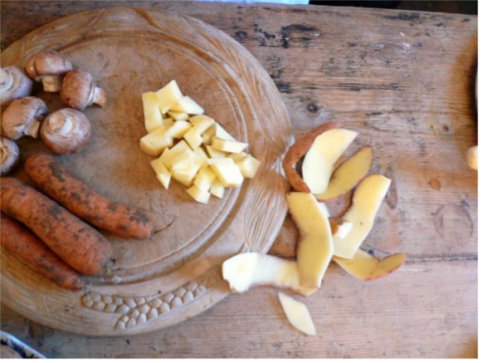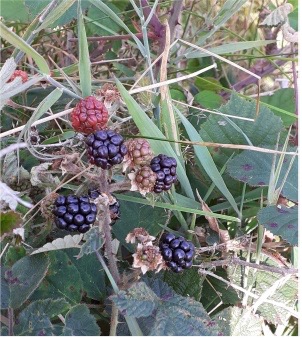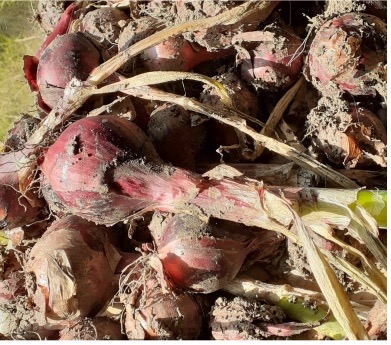 In Victorian times food was farmed locally could not be stored. Food was sold in small quantities at markets or small shops, and was eaten very shortly afterwards. The greater the distance to bring fresh food from the producers the more expensive it was. Market towns and towns on a railway line, canal or river were able to provide a greater selection. Certain foods were incredibly popular which was partly down to how readily available they were. These were: Beef, mutton, pork, bacon, cheese, eggs, bread, potatoes, rice, oatmeal, milk, vegetables in season, flour, sugar, treacle, jam and tea. Mill owners and shopkeepers might have meat daily, and cheese and bacon for supper. For those working on lower wages, meat would only be on the menu 2-3 times a week with a now increased volume of potatoes/vegetables. The amount of meat would continue to decrease until the poorest factory workers might be living on dripping, (the fat and juices left over from roasting meat) bread or potatoes, and tea.
In Victorian times food was farmed locally could not be stored. Food was sold in small quantities at markets or small shops, and was eaten very shortly afterwards. The greater the distance to bring fresh food from the producers the more expensive it was. Market towns and towns on a railway line, canal or river were able to provide a greater selection. Certain foods were incredibly popular which was partly down to how readily available they were. These were: Beef, mutton, pork, bacon, cheese, eggs, bread, potatoes, rice, oatmeal, milk, vegetables in season, flour, sugar, treacle, jam and tea. Mill owners and shopkeepers might have meat daily, and cheese and bacon for supper. For those working on lower wages, meat would only be on the menu 2-3 times a week with a now increased volume of potatoes/vegetables. The amount of meat would continue to decrease until the poorest factory workers might be living on dripping, (the fat and juices left over from roasting meat) bread or potatoes, and tea.
 Factory owners were responsible for providing their pauper apprentices with food. Sarah Carpenter, a child worker at Cressbrook Mill Derbyshire: "Our food for breakfast and supper was oatcake. It was thick and coarse. This oatcake was put into cans. Boiled milk and water was poured into it.” Locally in Cragg Vale the then vicar (Rev Thomas Crowther from 1821 – 1859), became well known in challenging the behaviour of the infamous mill owner Hinchcliffe Hinchcliffe. He demanded reform to the shocking conditions for employee welfare including the food given to his child labour workforce.
Factory owners were responsible for providing their pauper apprentices with food. Sarah Carpenter, a child worker at Cressbrook Mill Derbyshire: "Our food for breakfast and supper was oatcake. It was thick and coarse. This oatcake was put into cans. Boiled milk and water was poured into it.” Locally in Cragg Vale the then vicar (Rev Thomas Crowther from 1821 – 1859), became well known in challenging the behaviour of the infamous mill owner Hinchcliffe Hinchcliffe. He demanded reform to the shocking conditions for employee welfare including the food given to his child labour workforce.
The poorest people unable to work were housed in the local parish Workhouse. Their food primarily consisted of bread, cheese, broth, rice, milk, potatoes and gruel which was like thick porridge. The amount of food for the inmates was rationed and Oliver Twist in Charles Dickens’ novel is famous for asking for more. People working in rural areas might have a garden in which to grow food or keep hens. Those on the edge of the countryside with access to the hedgerows and local farms had a better diet and could forage for seasonal food growing wild: Mushrooms, Blackberries, Raspberries, Apples, Wild Garlic, Dock leaves & Nettles. Others tried stealing eggs from birds’ nests or “poaching”: illegally catching fish/ shooting rabbits or deer on land/from rivers that they were not legally permitted to enter.
 In 1908 the Small Holdings and Allotments Act placed a duty on local councils to provide sufficient allotments, according to demand for “the labouring poor.” After the end of the Great War anyone could apply to rent an allotment of 250 square metres to grow their own food or sell surplus (but not at a profit) or a different size by agreement. Today there are over 125,000 allotmenteers renting plots across the UK.
In 1908 the Small Holdings and Allotments Act placed a duty on local councils to provide sufficient allotments, according to demand for “the labouring poor.” After the end of the Great War anyone could apply to rent an allotment of 250 square metres to grow their own food or sell surplus (but not at a profit) or a different size by agreement. Today there are over 125,000 allotmenteers renting plots across the UK.
